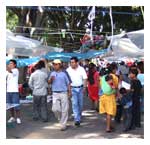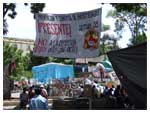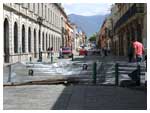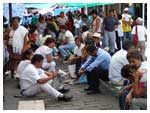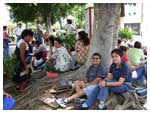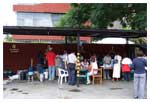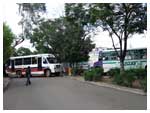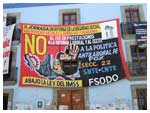
Barbara Joan Schaffer
October 29, 2006
The five-and-a-half-month occupation of the historic center of Oaxaca by teachers and various groups demanding the resignation of the governor ended today when thousands of federal police in full body armor, carrying assault rifles, marched in phalanxes supported by helicopters, tanks and water cannons to regain control of the access roads to the city and finally retake the Zócalo (the town square). Earlier in the week the teachers had voted to go back to work thus ending a strike begun in mid-May, leaving the anti-government movement in the hands of a popular front organization called APPO (Popular Assembly of the Oaxacan People).
I spent a week in Oaxaca at the end of August, and on September 1, I saw the Fifth Megamarch of SNTE, sección 22 (the Oaxacan branch of the National Union of Education Workers) and APPO. The photos on this page were taken between August 27 and September 1.
I don't pretend to understand what I observed. The occupation of the historic center of Oaxaca has been compared to the Paris Commune of 1871. But in this case the communards were a mixture of middle class professionals, students, workers, peasants and indigenous political groups. Buses and police cars were commandeered to make barricades, radio stations were taken over, government buildings closed, there was graffiti painted on the cathedral, and tourism came to a grinding halt depriving that sector of millions of dollars in lost revenues. On August 29, Standards and Poor lowered Oaxaca's bond rating because of the anticipated tax shortfall.
Think of pictures of the soldiers in the trenches during World War I. Think of hours, days of boredom punctuated by sporadic activity. By the end of August the teachers had been camping out in the Zócalo for three and a half-months. The women worked on their embroidery, the men played cards. People talked on their mobile phones.
When I arrived on Saturday August 26 the Zócalo seemed abandoned. There were banners everywhere, but very few people. The adjoining streets were also largely deserted. Sunday was the same. Had I not stayed longer I would have assumed the protests were over. Monday, however, was business as usual for the occupying army. Hundreds of APPO people filled the Zócalo, the public health workers sitting under their plastic tarp, the Communists under theirs and so on. Some of the side streets were assigned to the teachers, others to APPO, but all were filled with protesters calmly going about their business of just being there.
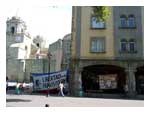
Cathedral and Hotel Marques del Valle.
As a veteran of many protest marches and rallies, I had expected more of a circus. At the very least people handing out fliers, singing, speeches. What I found were schoolteachers and health workers, people who are temperamentally conservative, people with a lot of self-control.
I would walk up to an encampment, introduce myself as a retired American teacher, and ask permission to take pictures. Then I would try to engage them in conversation about the protests. I was hoping that I might be directed to an information center. There was none and most of the teachers although polite were understandably not interested in talking to me; I might well have been a spy.
By virtue of getting lost walking back to my hotel, a mile from the Zócalo, I encountered a group of teachers sitting on a traffic island under the shade of large tree. The street was barricaded by a municipal bus. (I use the term teachers loosely, because the teachers' union includes administrators and support staff.) These protesters were a friendly group and were happy to answer my questions. I met with them over the course of three days.
My first question was how they justified closing the schools and depriving the children of an education. They told me of the misery of rural Oaxaca, children coming to school hungry, the lack of school supplies, the arcane system by which parents have to pay tuition at schools that are supposed to be free. (There are scholarships for poor families. Think of how community colleges are run in the States.) They said that as the most organized sector of the community they felt they had the moral responsibility to fight for the interests of the poor. Truly, the teachers do represent the poor in that middle class families send their children to private schools.

“Disease Control & Prevention - Present!”
On the second day they invited me to lunch at the Finance Ministry, which the teachers and APPO had closed down. The building was locked, but the parking lot had been turned into a mess hall. We stood on line, cafeteria style, took a paper plate, and were served chicken with beans, tortillas and tamarind juice. That day's food had been donated. Other days the teachers paid. After lunch we used the facilities - a row of toilets that were outside the ministry building. It was just like being in school.
The Oaxacan teachers union took its present shape in 1980 when it managed to wrest the organization from its old guard leadership which the teachers considered corrupt and undemocratic. It was a difficult struggle and in the end the Oaxaca branch of the National Union of Education Workers was the most radical in the country. I marveled at the level of organization and discipline that the occupation revealed and required, and I was told that it was the result of 26 years of protests. It has become a yearly ritual in Oaxaca for the teachers to go on strike in May and camp out in the Zócalo and for the government to reach an agreement before the school year begins in August. This year, however, the government did not play by the rules. First the governor refused to meet with the union. Then in the early morning of June 14, he sent the police into the Zócalo. The protesters were tear gassed on the ground as helicopters flew overhead. From that moment the teachers' demands for salary increases changed to the demand that the governor, Ulises Ruíz Ortíz, resign. A few days later APPO was formed as an independent organization in support of the teachers.
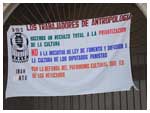
Santo Domingo Museum
“Anthopology Workers - We totally reject the privatization of
culture.” Banner protesting a federal plan to privatize museums.
Ruíz Ortíz belongs to the PRI, the party that ruled Mexico for 70 years but is now in third place in national politics. The leftist PRD party swept the state of Oaxaca in 2006, wresting most national assembly seats and a senatorship from the PRI. The governor was elected in 2004 by a very narrow margin. His opponent, who was elected to senate in 2006, had the backing of both the PRD and the right-wing PAN (the party of President Fox).
Wednesday 8/30/06
| Teachers at the barricades | Teachers sewing | Traffic island with teachers | ||
| Finance Ministry at lunch | Bus barricade | Teachers' union banner protesting PAN proposals to change worker health benefits. |
||
5th MEGAMARCH
Friday 9/1/06
APPO
The teachers and APPO formed two separate contingents in the 5th Megamarch with APPO marching in front. Triqui Indians belonging to MULT (Unified Movement of the Triqui Struggle) lead the march, followed by peasants, workers, and students. The Noticias de Oaxaca estimated 50,000 marchers. I took most of these pictures mid-route, in front of the Tourism Ministry. I stood there in rain and sun for over 3 hours. The first photos were taken at the organizing point of the march.
 |
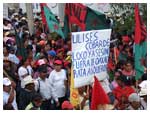 |
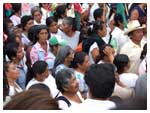 |
||
|
|
||||
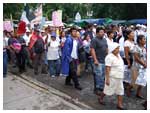 |
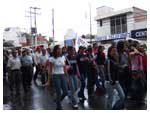 |
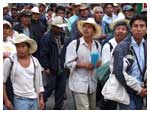 |
||
|
|
||||
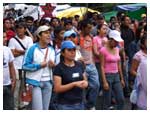 |
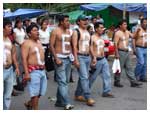 |
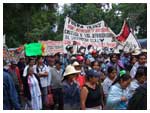 |
||
TEACHERS
The teachers made up the second half of the march and their numbers were more-or-less equal to that of APPO. The teachers who are looking disapprovingly in the direction of the camera are watching two teenage boys writing graffiti on the Tourism Ministry wall.
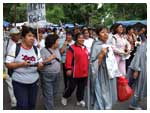 |
 |
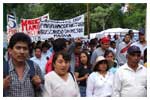 |
||
|
|
||||
 |
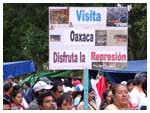 |
|||
|
|
||||
